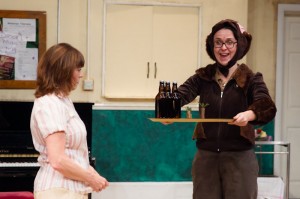Tim Firth’s phenomenally successful Calendar Girls has been performed on stage and movie screens across the globe but its run at the local Ealing theatre hut, Questors, is where the drama really comes to life.
Even without Helen Mirren or an expendable budget, the Questors simple props and am-dram cast came together to offer a moving, personable, and simply fantastic adaptation.
After all, simple props such as baked buns and flower-pots were the only items used to protect the women’s modesty for the calendar photo shoot.
From the opening scene of the Women’s Institute partaking in tai chi to the moment they decide to strip for the famous Yorkshire charity calendar, the bonds of friendship are evident both on and off the stage.
Despite the different personalities, from loud Cora, to life-experienced Jessie and the snobbish Celia, once Annie’s husband dies from Leukaemia, they harmonise to raise money for a communal sofa for the hospital which looked after John Clark.
And as the group debate the morality of an artistically ‘nude’ calendar (as opposed to the more common ‘naked’), we shared their every musing from lack of confidence, embarrassment to final empowerment and financial success.
Hannah Whiteoak who plays Ruth was a particular treat to witness.
Her slightly timid, introverted character was played out to comedic effect which balanced the heavier plot of illness and death.
And just when you’re not sure whether she’ll take part in the photo-shoot, she outshines all the ladies as she confidently stretches out her body on the table as fruit envelopes her humility.
Directed by Rachel Knightley (her first production), there were two scenes which really impressed.
In a sombre moment when John’s dying, the women all group together and stand around his wheelchair.
As his lines fade and the lights are dimmed, Annie’s lines overlap John’s as he slowly walks away into the shadows of the stage. It was very touching.
Another clever use of the set was when the WI received all the fan mail after sales of the calendar rocketed both in Yorkshire and abroad.
Letters were dropped to the floor from stage scaffolding above which was very novel.
Despite its amateur status, this is a fine production from Questors and a promising start for new director Rachel Knightley. It had me laughing and caught me crying at all the right moments.
Calendar Girls is running at Questors till Sat 10 Nov. To book tickets, visit: http://www.questors.org.uk/event.aspx?id=364
All photos are by Richard Mead.




